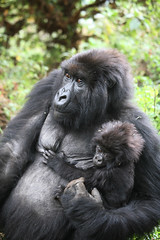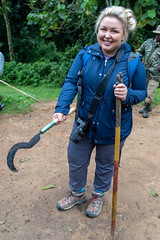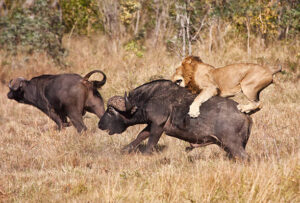Getting ready for a Uganda gorilla trekking vacation is a great way to experience one of the world’s most amazing wildlife encounters. It’s an exciting and fruitful Endeavor. More than half of the world’s mountain gorilla population is in Uganda, primarily in the Mgahinga National Park and the Bwindi Impenetrable National Park. To guarantee a successful and pleasurable stroll, preparation is necessary. Check out this thorough guide to help you prepare for this once-in-a-lifetime opportunity:
Uganda Gorilla Trekking explained
The activity known as “gorilla trekking” involves hiking through Uganda’s deep forests to see mountain gorillas in their natural setting. Depending on where the gorillas are located and how challenging the surrounding terrain is, these climbs can take several hours or perhaps a whole day.
Where can you do Uganda Gorilla Trekking?
More than 400 mountain gorillas can be found in Bwindi Impenetrable National Park, which is a UNESCO World Heritage site. The gorillas are divided into multiple habituated groups.
Mgahinga National Park is a great place to explore and observe a variety of wildlife and other primates, despite being smaller and having fewer gorillas.
Organizing Your Uganda Gorilla Trekking Vacation
When Is the Best time to Go?
The best times to go trekking are during the dry seasons (June to September and December to February), when there is less rain and simpler access to the routes.
October to November and April to May are the Wet Seasons. Muddy routes make trekking more difficult during certain seasons, but there are less tourists and breathtaking scenery to take in.
Guidelines and permits for Uganda Gorilla Trekking
Gorilla Licenses
Because the number of permits for gorilla trekking is limited, obtaining a permit in advance is imperative. By 2024, a permit will run you about $800.
Age Limitations for Uganda gorilla trekking
To go gorilla trekking, you have to be at least 15 years old.
Fitness Level
Because of the steep, rough, and occasionally muddy routes, going on a gorilla trekking adventure can be physically taxing. Good physical health will result in better experiences. To improve stamina, regular cardiovascular exercises like walking, cycling, trekking, or jogging are advised.
Health Measures for Uganda gorilla trekking
Verify that you have received all recommended vaccinations. Immunizations against typhoid, yellow fever, rabies, and hepatitis A and B are also advised in Uganda.
Malaria prevention
Uganda is endemic for malaria. For antimalarial medication, speak with your doctor. You should also take precautions like applying bug repellent and sleeping under mosquito netting.
Travelers’ Insurance
Having comprehensive travel insurance that covers medical emergencies, trip cancellations, and hiking activities is imperative.
Things You Need to Bring to Uganda gorilla trekking
Airy and Breathable Layers
For the varying humidity and temperature, quick-drying shirts and jeans are perfect.
Put on a jacket and waterproof pants to protect yourself from the rain and other damp circumstances.
Robust Hiking Shoes
These boots are supportive around the ankle, comfortable, and waterproof. They work well in rough terrain.
Put on gaiters to keep insects and dirt out of your boots.
Gloves and a hat
Wear gloves to guard against the cold and higher-altitude plants, and a wide-brimmed hat to screen against the sun.
Instruments and Add-ons
A daypack is a compact, cozy backpack designed to hold necessities like additional clothes, water, and food.
Hiking requires staying hydrated, whether you use a water bottle or a hydration pack.
Energy-dense snacks
Nuts, energy bars, and dried fruit are a few types of snacks.
Carry a Walking stick on your Uganda gorilla trekking safari
You can bring your own for extra stability, but hiking guides typically supply them.
A camera and binoculars
To photograph the breathtaking landscape and fauna. Recall treating the gorillas with respect and avoid using flash photos.
Use insect repellent and sunscreen to shield yourself from the sun’s rays and insects.
There are trekking experience guides and rangers on the trek. Alongside you will be knowledgeable guides and rangers who will impart essential knowledge about the gorillas, vegetation, and animals. They bear accountability for your security as well.
Habituation of Gorillas: The gorillas will allow you to observe them up close because they are used to human presence. Keep a respectful distance of at least 7 meters to reduce disturbance.
Trekking Etiquette
Observe the Directions
Never disregard the advice that your advisers provide you. By doing this, you can be confident that the gorillas will be safe and healthy.
Remain Calm
Reduce the loudness of your sound to help you get a better chance of getting a close-up look at the gorillas without frightening them.
Get rid of all of your waste while being mindful of the surrounding vegetation as a sign of respect for the environment.
Extracurricular Activities in Uganda
The Environment and Wildlife
The varied fauna of Queen Elizabeth National Park, which includes lions, elephants, and hippos that climb trees, is well-known.
The Murchison Falls National Park is well-known for its magnificent waterfall and diverse array of fauna.
Relationships Between Cultures
Through storytelling and cultural tours, learn about the customs and traditions of the native Batwa people who inhabit the Bwindi Forest.
Local markets & artisan Villages
Visit Uganda’s artisan villages and marketplaces to buy one-of-a-kind souvenirs and show your support for regional artists.
Logistics of Travel
How to Get to Uganda Gorilla trekking
Take-offs
The primary entry point is Entebbe International Airport (EBB), which has connections to important places across the globe.
Visas
Most visitors to Uganda need a visa in order to enter the country. You can apply online or pick up an electronic visa in person.
Shifting Road Travel
Private shuttles and rented vehicles are two popular modes of transportation. 4×4 cars are advised because there may be unpaved roads going to trekking locations.
Domestic Flights
Operating out of provincial airports close to national parks, domestic flights provide faster access to more isolated destinations.
Options for Lodging
Types of Accommodation
Luxurious Lodges
Typically found near the starting points of trekking, these establishments offer lavish comforts and amenities.
Mid-Range Lodges
Offer cozy, reasonably priced accommodations furnished with all the necessities.
Low-cost Accommodations: Basic housing alternatives for travelers on a small budget include campgrounds and guesthouses.
Reservation Advice
Make your reservations well in advance, since there are often just a few spots available for your accommodations—especially during the busiest seasons of the year.
Closeness to Trekking Sites
To cut down on travel time on the day of your journey, select lodges that are close to the locations where your climb will start.
Security and Safety
Generally Secure Advice
Stay Updated
Ensure that you are informed about any local news and travel warnings.
Use hotel safes to safeguard personal belongings, and exercise caution when bringing valuables out in public.
Well-being and Manners
Safe Drinking Water
To prevent contracting illnesses from waterborne infections, use filtered or bottled water.
Suggestions for maintaining food safety include eating only at reliable restaurants and avoiding undercooked or uncooked food.
A morning briefing on the day of Uganda gorilla trekking
Registration
Come early to park headquarters so that park rangers can register you and give you a briefing.
Each trekking party is allocated to a certain family of gorillas.
Depending on how hard they are, the Trip Treks might take several hours or an entire day.
Observation Time of Uganda gorilla trekking
You will have about an hour to watch and photograph the gorillas after you find them.
After Uganda gorilla trekking Certificate
As a keepsake of your journey, you will receive a certificate upon finishing the trek.
Relaxation
Give yourself enough time to unwind and make travel plans. Many lodges include comfortable lounges with spa treatments to help guests unwind.
In conclusion
Ugandan gorilla trekking is a unique experience that calls for thorough preparation, environmental awareness, and cultural awareness. It is possible to guarantee a secure, entertaining, and memorable event by heeding these recommendations. The excitement of seeing mountain gorillas in their natural home will leave a lasting impact and a deep appreciation for these wonderful creatures and the efforts to maintain their environment, regardless of whether you are an experienced traveler, or this is your first wildlife excursion.





